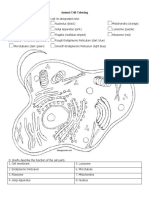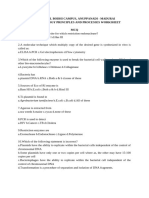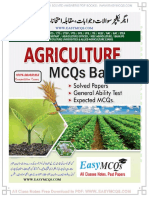Biotechnology Principles and Processes, Biotechnology and Its Applications-Split
Uploaded by
kksah0200Biotechnology Principles and Processes, Biotechnology and Its Applications-Split
Uploaded by
kksah0200Biotechnology Principles and Processes, Biotechnology and its
Applications
PART-1 (SECTION-A) (1) BamH I
1. Which of the following is a biotechnological (2) Sal I
product- (3) Hind II
(1) Vaccine (4) EcoR I
(2) Enzymes 9. Hind II cuts DNA at a specific sequence of
(3) Cheese (1) 5 base pairs
(4) All of these (2) 7 basepairs
2. Making multiple copies of any template DNA in a (3) 6 base pairs
host cell is known as (4) 8 base pairs
(1) Replication 10. In the nomenclature of restriction endonuclease
(2) Transcription enzyme the first letter and the successive two
(3) Reverse transcription letters denote
(4) Cloning (1) Strain, Genus
3. Given below are two statements : one is labelled (2) Genus, strain
as Assertion (A) and the other is labelled as Reason (3) Genus, species
(R) (4) Strain, species
Assertion (A) : EcoRI comes from Escherichia coli 11. EcoR I is isolated from
RY13 (1) E.coli RY11
Reason (R) : In EcoRI the letter 'R' is derived from (2) E.coli RY13
the name of statin (3) E.coli RY10
In the light of the above statements, choose the (4) E.coli RY15
correct answer from the options given below : 12. What is correct about Hind-II
(1) Both (A) and (R) are correct but (R) is not the correct (1) It is the first restriction endonuclease
explanation of (A) (2) Its functioning depends on a specific DNA
(2) (A) is correct but (R) is not correct nucleotide sequence
(3) (A) is not correct but (R) is correct (3) It cuts DNA by identifying a specific sequence of
(4) Both (A) and (R) are correct and (R) is the correct six base pairs
explanation of (A) (4) All of these
4. Stanley Cohen isolated the antibiotic resistance 13. The speci fic sequence recognized by
gene and linked it to a native plasmid of endonuclease is called-
(1) Salmonella typhimurium (1) Parallel sequence
(2) Salmonella pneumoniae (2) Palindromic nucleotide sequence
(3) Saccharomyces cerevisiae (3) Polynucleotide sequence
(4) E. coli (4) None of these
5. Molecular scissors are- 14. The fragments of DNA produced by restriction
(1) Helicases digestion are separated by
(2) Restriction endonucleases (1) Chromatography
(3) Ligases (2) Gel electrophoresis
(4) Topoisomerases (3) Centrifugation
6. Which of the following is a vector (4) None of these
(1) Plasmid 15. Given below are two statements :
(2) Cosmid Statement I : In the year 1963, the three enzymes
(3) Phagemid responsible escherichia coli were isolated.
(4) All of these Statement II : The first restriction endonuclease -
7. The new DNA molecule generated by the linking Hind II Choose the correct answer from the options
of foreign DNA to vector is called given below
(1) Plasmid DNA (1) Both Statement I and Statement II are incorrect
(2) Recombinant DNA (2) Statement I is correct but Statement II is incorrect
(3) Combination DNA (3) Statement I is incorrect but Statement II is correct
(4) Chromosomal DNA (4) Both, Statement I and Statement II are correct
8. The first restriction endonuclease isolated was 16. Under an electric field DNA moves towards :
By – Anmol Sharma Sir 1|P a g e
You might also like
- Download Full The Personality Puzzle 7th Edition David C. Funder PDF All Chapters86% (7)Download Full The Personality Puzzle 7th Edition David C. Funder PDF All Chapters60 pages
- Biotechnology Principles and Processes, Biotechnology and Its ApplicationsNo ratings yetBiotechnology Principles and Processes, Biotechnology and Its Applications16 pages
- 11 Biotechnology-Principles N Processes-Entrance Questions N AnswersNo ratings yet11 Biotechnology-Principles N Processes-Entrance Questions N Answers4 pages
- NEET Important Questions For Biotechnology - Principles and Processes With Solutions Free PDF DownloadNo ratings yetNEET Important Questions For Biotechnology - Principles and Processes With Solutions Free PDF Download28 pages
- Biotech Principles and Processes 1694155610No ratings yetBiotech Principles and Processes 16941556103 pages
- 19 Biotechnology - Principles and Processes: SolutionsNo ratings yet19 Biotechnology - Principles and Processes: Solutions10 pages
- Biotechnology Principles & Processes WorksheetNo ratings yetBiotechnology Principles & Processes Worksheet6 pages
- NEET (Biotechnology I & II) 13-08-2023 [LT24 HYBRID (Online)]No ratings yetNEET (Biotechnology I & II) 13-08-2023 [LT24 HYBRID (Online)]5 pages
- Biotechnology principles and processes WS 1 QUESTIONSNo ratings yetBiotechnology principles and processes WS 1 QUESTIONS7 pages
- Biotechnology Principles & Processes by MadXAbhiOfficialNo ratings yetBiotechnology Principles & Processes by MadXAbhiOfficial11 pages
- Biotechnology - Principles and Processes _ Practice SheetNo ratings yetBiotechnology - Principles and Processes _ Practice Sheet7 pages
- Biotechnology Principles and Processes Practice Sheet SolutionNo ratings yetBiotechnology Principles and Processes Practice Sheet Solution52 pages
- Biotechnology and Its Applications - 35081431 - 2024 - 06 - 22 - 13 - 36No ratings yetBiotechnology and Its Applications - 35081431 - 2024 - 06 - 22 - 13 - 3610 pages
- Case Study of Chapter Biotechnology Principles ..No ratings yetCase Study of Chapter Biotechnology Principles ..8 pages
- Section A //X Choose Correct Answer From The Given Options. (Each Carries 1 Mark)No ratings yetSection A //X Choose Correct Answer From The Given Options. (Each Carries 1 Mark)11 pages
- Hssreporter•Com_Chapter 2 Biotechnology _ Principles and Processes With KeyNo ratings yetHssreporter•Com_Chapter 2 Biotechnology _ Principles and Processes With Key13 pages
- Biotechnology- Principles and Processes_compressedNo ratings yetBiotechnology- Principles and Processes_compressed9 pages
- Mock Test On Biotechnology - Principles and Processes For NEETNo ratings yetMock Test On Biotechnology - Principles and Processes For NEET12 pages
- BIOLOGY - Assignment: Chapter: Biotechnology: Principles and Processes & Biotechnology and Its ApplicationsNo ratings yetBIOLOGY - Assignment: Chapter: Biotechnology: Principles and Processes & Biotechnology and Its Applications9 pages
- Top 100 MCQs Biotechnology Principles and Processes 25 NovNo ratings yetTop 100 MCQs Biotechnology Principles and Processes 25 Nov101 pages
- SF Oq BT Pop and Its Applications For SharingNo ratings yetSF Oq BT Pop and Its Applications For Sharing104 pages
- Biotechnology Principle and Processes QuizNo ratings yetBiotechnology Principle and Processes Quiz62 pages
- Biotechnology Principles and Process - DPP-02 (Of Lecture-03)No ratings yetBiotechnology Principles and Process - DPP-02 (Of Lecture-03)4 pages
- DPP - Biotechnology Principles and ProcessesNo ratings yetDPP - Biotechnology Principles and Processes4 pages
- XII CH - 11 Biotechnology Process - PrincipleNo ratings yetXII CH - 11 Biotechnology Process - Principle13 pages
- 65ae549850685e0018891aab_##_Biotechnology _ Principles and Processes _ Practice Sheet __ VIJETA SERIES CLASS-12THNo ratings yet65ae549850685e0018891aab_##_Biotechnology _ Principles and Processes _ Practice Sheet __ VIJETA SERIES CLASS-12TH6 pages
- Golden DPP of Biotechnology Principles and Processes by Garima MamNo ratings yetGolden DPP of Biotechnology Principles and Processes by Garima Mam5 pages
- 6 - Questionários - Engenharia Genética e Diagnóstico - 230415 - 161324 - 230606 - 125049No ratings yet6 - Questionários - Engenharia Genética e Diagnóstico - 230415 - 161324 - 230606 - 12504921 pages
- Textbook of Biochemistry with Clinical Correlations 7th Edition Devlin Test Bank downloadNo ratings yetTextbook of Biochemistry with Clinical Correlations 7th Edition Devlin Test Bank download48 pages
- Biology_XIIth_Biotechnology - Principles and ProcessesNo ratings yetBiology_XIIth_Biotechnology - Principles and Processes3 pages
- Chapter 3 - Motion in A Straight Line-SplitNo ratings yetChapter 3 - Motion in A Straight Line-Split1 page
- Kemampuan Kognitif Dan Persepsi Mahasiswa Terhadap Mata Kuliah GenetikaNo ratings yetKemampuan Kognitif Dan Persepsi Mahasiswa Terhadap Mata Kuliah Genetika10 pages
- Cell Division Student Exploration Doc - Alfonso Rubio-Medina100% (1)Cell Division Student Exploration Doc - Alfonso Rubio-Medina6 pages
- Roll. No Name Project Topic: Affiliation No: 2133841 School Code: 71901No ratings yetRoll. No Name Project Topic: Affiliation No: 2133841 School Code: 719016 pages
- ICSE Class 10 Biology Previous Year Question Paper 2015No ratings yetICSE Class 10 Biology Previous Year Question Paper 20158 pages
- Expression of CircRNA Aptamers in Cells Using Autocatalytic Transcripts NatBiotech 2019 GOODNo ratings yetExpression of CircRNA Aptamers in Cells Using Autocatalytic Transcripts NatBiotech 2019 GOOD15 pages
- Cleavage: Cleavage Is A Series of Extremely Rapid Mitotic Divisions That Immediately Follow FertilizationNo ratings yetCleavage: Cleavage Is A Series of Extremely Rapid Mitotic Divisions That Immediately Follow Fertilization14 pages
- 4.monodansylpentane As A Blue-Fluorescent Lipid-Droplet Marker For Multi-Color Live-Cell ImagingNo ratings yet4.monodansylpentane As A Blue-Fluorescent Lipid-Droplet Marker For Multi-Color Live-Cell Imaging8 pages
- Single-Cell and Spatial Transcriptomics Reveal Metastasis Mechanism and Microenvironment Remodeling of Lymph Node in OsteosarcomaNo ratings yetSingle-Cell and Spatial Transcriptomics Reveal Metastasis Mechanism and Microenvironment Remodeling of Lymph Node in Osteosarcoma19 pages
- B5773f4ffa6afa04fd903699cf8 15c491ba 1718C5No ratings yetB5773f4ffa6afa04fd903699cf8 15c491ba 1718C529 pages






























































































